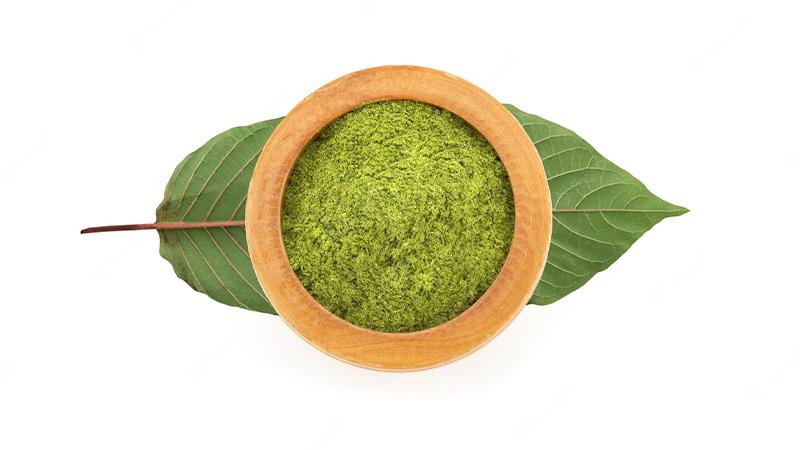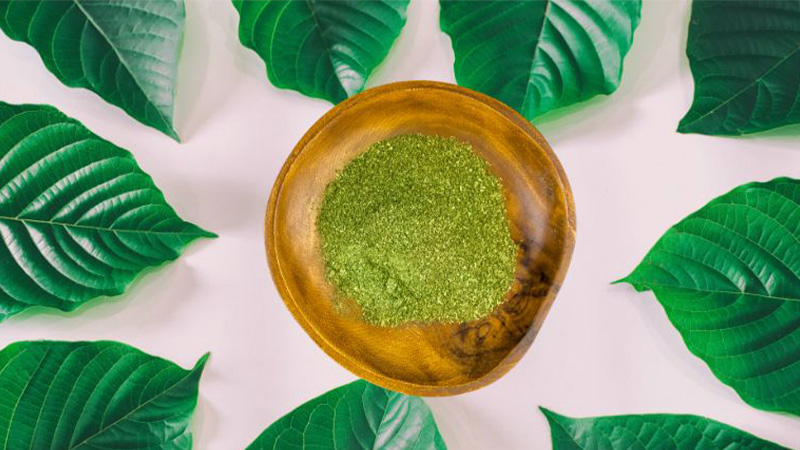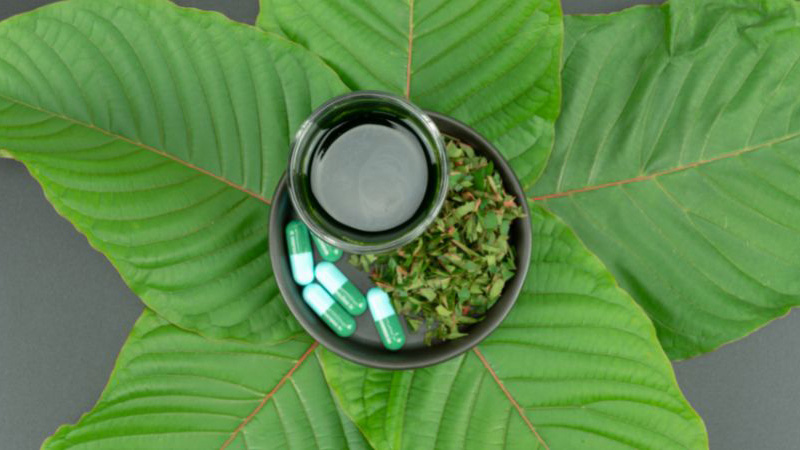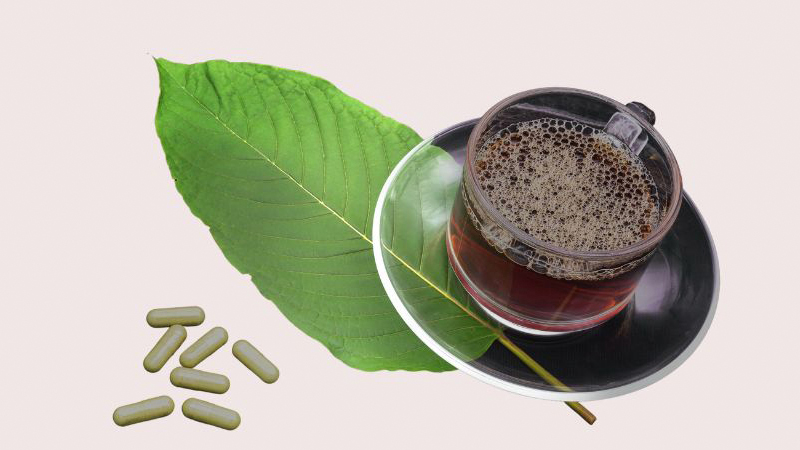What Is Kratom? Uses, Side Effects & More

Kratom is an evergreen tree originating from Southeast Asia. The leaves are used as both a stimulant and painkiller, depending on the dose.
An estimated 15 million people use kratom on a regular basis in the United States. The main reason people turn to kratom is to avoid other, more addictive painkillers like oxycodone or hydrocodone.
In this article, you’ll learn everything there is to know about kratom and its unique properties. You’ll discover how it works, what options are available, how to stay safe, and many other insights into this remarkable herb.
What Is Kratom?
Kratom is native to Southeast Asia and belongs to the Rubiaceae family (AKA the coffee family). It grows natively in Thailand, Indonesia, the Philippines, and Papua New Guinea.
The herb’s main features are its stimulant and relaxing effects, which vary according to the dose. It achieves these effects by interacting with the opioid receptors in the brain, resulting in reduced pain and euphoria, among other benefits.
The botanical name for kratom is Mitragyna speciosa. It was first described in 1839 by botanist Pieter Korthal. However, this herb has been used for much, much longer than this. Locals would chew kratom to fight fatigue and pain, combat diarrhea, and treat a variety of other unrelated ailments dating back hundreds of years ago. Today, it’s also used within indigenous communities as a treatment for opiate withdrawal.
The first user reports for kratom in the Western world started appearing in 2001. Its popularity has been rising steadily since then, with dozens of new vendors entering the market yearly and millions of daily users. The main driver of kratom’s popularity is that it’s viewed as a safer alternative to prescription opiates — which are well-established at this point for being highly addictive and often lead to debilitating mental illness.
Kratom isn’t without its risks, but the evidence clearly supports that this herb is less addictive and less damaging than its synthetic pharmaceutical counterparts (more on this later).
Where Does Kratom Come From?
Kratom trees grow naturally in dense tropical rainforests but can also be farmed in certain tropical locales.
Due to the trees’ need for hot weather and muggy humidity, their growth is limited to regions that can naturally support this climate. This tree is too large to be grown efficiently in greenhouses. For this reason, almost all kratom comes from Southeast Asia, though you may find a few farms in places like Hawaii or Florida as well.
The herb comes from processing the tree leaves after they fall off or as workers harvest them. The leaves are green and glossy and will eventually fall as they mature, soon replaced by new ones.
According to the maturity of the leaves, the chemical composition will vary, giving way to three distinct types of kratom — green vein, red vein, and white vein kratom.
The workers then leave them to dry in the sun, later to be ground into powder.
The drying process is as important as the maturity of the leaves, as it can also change the chemical composition and alter the effects of the herb. We’ll discuss these effects in depth, including all of kratom’s potential benefits.
What Does Kratom Feel Like?

Kratom offers many physical and psychological effects, and they vary on two factors: dose and strain. Lower doses are usually more stimulating, while higher doses are more calming.
Likewise, some strains are better for energy, while others are more effective against pain. We’ll discuss the differences between the strains later on.
Kratom’s physical effects include energy and mood boosts, reduced pain, and appetite suppression. Higher doses take on a different character — producing feelings of sedation, euphoria, strong pain relief, and a mild intoxication similar to alcohol (but more euphoric).
Too large of a dose, however, can lead to headaches, nausea, weariness, and hangover-like feelings.
What Is Kratom Used For?
Kratom has many uses, and experienced users can learn to dial in the effects they want based on the dose and strain choice.
The most common reason people use kratom is to alleviate chronic pain. It’s also popular among students, business professionals, and laborers as an energizer similar to coffee.
Here, we’ll explore the use of kratom in more detail.
1. Energy & Focus
Kratom works as a stimulant and nootropic, similar to caffeine from coffee. In doses ranging from 1 to 3 grams, kratom acts as an adrenergic agonist — providing double duty on blocking fatigue and actively increasing electrical activity in the brain.
The primary alkaloid responsible for this effect is mitragynine, which has been shown to increase norepinephrine levels in the brain — leading to feelings of alertness, focus, and energy. These effects remain in place for about 2 or 3 hours before redosing becomes necessary.
Kratom capsules, tinctures, or gummies are the most common method of consumption for this purpose, but kratom powder can be used effectively too.
2. Pain Relief
Kratom is an impressive pain reliever because it targets several pain pathways in the brain. The majority of this effect comes from an alkaloid called 7-hydroxy-mitragynine, which is highest in red vein strains. This alkaloid activates opiate receptors in the brainstem and spinal cord to mute pain signals before they reach the brain.
Kratom works to relieve pain as well through its muscle-relaxant and anti-inflammatory capabilities.
3. Anxiolytic & Antidepressant
As a byproduct of kratom’s ability to interact with multiple neurotransmitter systems — including dopamine, serotonin, norepinephrine, and opiate receptors — kratom also offers a distinct mood-enhancing effect. In higher doses, kratom can even be described as euphoric.
This makes kratom a good option for the short-term treatment of depression and anxiety.
It’s important to note that kratom is not a cure for either of these conditions. It acts merely as a bandaid to help users through difficult situations. Long-term use of kratom can worsen depression worse, so it’s important to combine kratom with other therapies, such as talk therapy, cognitive behavioral therapy (CBT), psychedelic-assisted psychotherapy (PAP), and other modalities.
4. Insomnia
The stimulating effects of kratom transition into sedation in doses over 6 grams, which makes higher doses useful for alleviating problems with insomnia. Kratom is especially useful for people suffering from insomnia aggravated by chronic pain.
Using kratom for sleep support involves taking the herb at least an hour before the desired bedtime. First, kratom causes a burst of energy, but this is quickly overpowered by a sense of heaviness. The muscles feel more relaxed, and it becomes difficult to maintain complex thoughts — making it much easier to fall asleep.
Some people note a sense of grogginess when waking the following morning if they took too much kratom. If this happens, the best course of action is to simply take less next time. Repeat this process until you no longer feel groggy the next morning.
Kratom Strains: Tips on Choosing the Best Strain
As we mentioned before, the maturity of the kratom leaves is responsible for the various types of kratom, which we call strains. The best way to differentiate them is by the color of the stem and vein. There are three primary vein colors: white, green, and red. However, once the leaves are dried and powdered, the color is no longer noticeable. Kratom vendors label the strains and colors for easy selection.

White Vein Kratom Strains

Use coupon CFAH for 10% OFF
These strains have the highest concentration of mitragynine, making this white strain the most stimulating of the three. As its effects are comparable to caffeine, many people use it every morning as an alternative to coffee.
The white vein strains are excellent aids to gaining more focus, boosting your energy and mood, and even managing feelings of depression. They can also serve as effective analgesics, though they aren’t the best at it.
These are some of the most popular white-veined kratom strains:
- White Borneo: This strain has immense energetic and mood-enhancing effects, perfect for a long study session or getting through a hard day’s work.
- White Hulu: Most prized for its intense stimulating effects, users compare the experience to the feeling you get after drinking a few cups of coffee.
- White Jongkong: This variety will give you laser-sharp focus and a tremendous energy boost to get stuff done.
- White Malay: One of the most energizing strains, White Malay will also induce euphoria and provide mild anxiety relief.
- White Sunda: This strain is highly stimulating and will boost your mood and focus even in small amounts.
Green Vein Kratom Strains

Use coupon CFAH for 10% OFF
The green-veined strains have a more balanced alkaloid composition. As a result, people consider this type to be midway between white and red. Of course, there are variations, so these green strains can lean either to the stimulant or relaxing side.
You could consider this type as a jack-of-all-trades. These strains’ effects can rival the red and white varieties, and their popularity makes them very easy to find.
These are some of the most popular green-veined kratom strains:
- Green Bali: This strain will provide a nice energy boost and solid pain relief without adverse side effects, such as feeling jittery or anxious.
- Green Elephant: This rare variety gets its name from its large, elephant-shaped leaves and produces balanced effects that won’t overwhelm you.
- Green Kali: This well-balanced strain provides a complete kratom experience, as it produces impressive, energetic effects and lifts your mood, followed by mild relaxation.
- Green Sumatra: It is primarily known for its productivity-enhancing benefits, capable of boosting your mood and energy.
- Green Vietnam: This strain is remarkably well-balanced, offering mild pain relief and stimulating effects.
Red Vein Kratom Strains

Use coupon CFAH for 10% OFF
Opposite the white strains, the red ones hold the highest concentration of 7-hydroxymitragynine. As that alkaloid is responsible for most of the kratom’s relaxing and pain-relieving effects, the red types of strains are best suited for those purposes.
The red vein strains excel as analgesics and anxiolytics. Some have even gone as far as using them in place of their pain medications. Furthermore, this type’s soothing qualities can help if you have trouble falling asleep.
These are some of the most popular red-veined kratom strains:
- Red Borneo: This strain’s soothing qualities are top-notch, and it is considered one of the best kratom products for anxiety.
- Red Dragon: If you’re looking for pain and anxiety relief, look no further, Red Dragon will blow your mind.
- Red Indo: This variety provides solid sedating effects and works best as a pain reliever that boosts your mood.
- Red Papua: This strain is a powerfully soothing strain that will provide a balance between pain relief and mood elevation without being as fatiguing as other varieties.
- Red Thai: Popular as an anxiolytic, Red Thai is also helpful for managing pain.
Types of Kratom Products
Most retailers sell kratom in three formats: powder, capsules, and tinctures. Each has pros and cons, but it comes down to personal preference.
Kratom Powder
Kratom powder is the most used, and you’ll find it in every specialized shop. As we mentioned before, it comes from the grinding of kratom leaves. While convenient to transport and measure, it has a bitter, grassy taste.
Kratom Capsules
Capsules avoid that by holding the powder in a gelatin shell. Unfortunately, they only hold a small amount, so you might have to take several to reach a high dose. High amounts of gelatin can, however, upset your stomach.
Kratom capsules are best used for smaller doses. They’re most often used by people who take kratom for its energizing benefits but aren’t as useful for people who need high dose pain-relief.
Kratom Tinctures
The third most common form of kratom products is tinctures. They come from dissolving kratom powder or leaves in an alcohol or oil solution. Tinctures have a long shelf-life, are easy to use, and offer fast onset of effects if held under the tongue before swallowing.
Kratom Dosages

Doses typically range from 2 to 12 grams of powder, with low doses ranging between 2 to 5 grams and high ones from 6 to 12 grams. A 12-gram dose is considered a heavy one, though, and you should avoid it, at least when beginning.
Additionally, you could find the approximate size of your ideal kratom dose by doing a simple calculation. If you need an energy boost, aim for 0.025 to 0.03 grams per pound of body weight. If you want to relax or relieve pain, take from 0.04 to 0.06 grams per pound.
However, if you’re new to kratom, we recommend you start with a low dose to see how your body responds. If there are no adverse effects, you can increase the amount by 1 or 2 grams until you reach the desired effects.
How to Take Kratom
Historically, people took kratom in two simple ways: chewing the leaves or making tea with them. As most of the kratom in the market is in powder form, people have created new methods to ingest it as quickly as possible.
If you opt to use kratom powder, the following methods will help you make the most of it without having to cope with its harsh taste.
The most common way to take kratom powder is to mix it with a tasteful beverage, like orange juice, lemonade, or tea. Depending on the resulting flavor, you may need to add a sweetener — kratom is very bitter.
In addition, the internet has many kratom food recipes you can try. Lots of users say that kratom pairs very well with chocolate.
Here are other methods to try.
The Toss-and-Wash Method
In the toss-and-wash method, you simply place a dose of kratom powder in your mouth and then drink a liquid, like a glass of water, juice, or tea. It’s very effective once you get the hang of it.
If the dose is large, it is advisable to divide it into smaller ones. That way, you prevent choking or breathing it in.
Making Kratom Tea
If you prefer a more traditional and relaxing method, making kratom tea is the one for you. Best of all, you can make it a unique experience by tailoring it to your tastes.
The process is straightforward and requires you to do the following: heat a cup of water just below boiling temperature, place the kratom powder in a tea bag, and then into the hot water. Let the tea bag steep for about 10 minutes, then remove it.
You can then add sugar or your sweetener of choice, or you may combine it with other herbal drinks like green tea or chamomile.
Kratom Parachute or “Bombing”
Kratom parachuting is the quickest way to experience the herb’s effects while avoiding the powder’s bitterness. We don’t advise using this approach unless you are an experienced user since it poses a choking risk.
The technique entails wrapping the dose in a piece of thin paper. Once you seal the wrapping well, you ingest it like a capsule with a glass of water. When the “capsule” hits the stomach, the wrapping dissolves quickly, and the kratom is absorbed.
Methods to Avoid
While some people use these methods seemingly without issue, we recommend you avoid them as their side effects could be harmful to your body and health in the long term. Therefore, our advice is this: do not smoke or snort kratom.
Smoking kratom can lead to lung damage, coughing, shortness of breath, and a weakened immune system. If you instead snort it, you could end up with nosebleeds, nasal blockage or inflammation, respiratory system infections, and more.
We want kratom to improve your well-being, so only resort to the above-recommended methods. People have proved these to be safe, and millions use them daily with no issues.
Kratom Potentiators: Making Kratom Stronger
There are several ways to increase the potency of kratom using “potentiators.” These substances work in different ways to boost the effects of kratom. Some do this by slowing down their metabolism (making the effects last longer), improving absorption, or adding to the effects of kratom by taking other herbs/substances with similar effects.
Here’s a list of kratom potentiators:
- Grapefruit Juice
- Valerian Root
- Chamomile
- Turmeric
- Black Seed Oil
- Cayenne Pepper
- Antacids
- Agmatine
- Magnesium
In addition, there are two other easy ways to make the effects kick with more strength. The first one consists of freezing kratom.
Start by soaking your kratom in some water for a little while. After that, take it out and give it a good shake before freezing it. The plant’s cell walls will rupture and dissolve, releasing the alkaloids and thus making the herb more potent.
The other method is effective only if you’ve already been using kratom for a while. As the body builds tolerance over time, a short break (1–2 weeks) can reset your body. The next time you take the herb, you’ll feel enhanced effects while using the same dose.
How Long Does Kratom Take to Work?
Kratom’s effects kick in within 20 to 30 minutes. After entering your body, the effects gradually increase in strength until they reach maximum potency one to two hours later. The duration of the entire event will be two to eight hours, but the average is three.
Of course, it will also depend on other factors, such as the dose, the method you’ll use to take it, and the strain of choice. Even something as simple as an empty stomach can massively affect the time the herb takes to work.
Kratom capsules take the longest time due to the gelatin shell that needs to dissolve before the body can absorb the powder. In turn, kratom powders are the fastest to act, while tinctures stand in the middle.
Is Kratom Safe?

Like most other substances, kratom is safe if you use it responsibly. It’s entirely possible to abuse kratom and become addicted. It’s also possible to take too much kratom, leading to a variety of uncomfortable side effects.
In general, if you stick within the recommended dosage range for kratom, avoid mixing the herb with other drugs or alcohol, and avoid using kratom as a crutch, the risks involved with taking kratom will remain low.
Kratom Side Effects
Kratom is a psychoactive substance, and as such, it can cause several side effects. They aren’t particularly harmful, but they could quickly turn your experience into a bad one. As always, if you’re careful, you can avoid the majority of them.
The most common side effects include (but aren’t limited to):
- Nausea and vomiting
- Lethargy and sedation
- Dizziness
- Constipation
- Brain fog
- Anxiety
You can prevent these by staying hydrated, decreasing your dosage, switching strains, avoiding kratom on an empty stomach, or simply not using kratom every day.
Furthermore, research suggests there could be long-term effects to using too much kratom, such as liver damage, hormone production changes, mood swings, or low libido. Still, researchers found these results are from overusing kratom over long periods.
Is Kratom Addictive?
Yes, kratom can be addictive.
Like any other substance that provides relief from pain or enhances your mood and energy, kratom can produce dependence.
The first symptoms of addiction are the craving for the effects of kratom. At this point, it’s a mental need for the one item that relieves you from pain and anxiety.
Then come the symptoms of physical dependence, when the body becomes accustomed to the permanent presence of kratom. If you don’t get a dose, you start getting withdrawal symptoms and feeling ill.
Fortunately, these withdrawal symptoms aren’t as severe as with opioids or other drugs. After an appropriate withdrawal time, the body regains balance, and the feeling of discomfort is gone.
If you need help, there are plenty of resources and support groups online that you can rely on to overcome addiction. We particularly recommend subreddits such as /r/quittingkratom and /r/addiction.
Is Kratom Legal?
Kratom is a bit controversial — some people herald it as a possible solution for the opiate addiction epidemic sweeping the world — others claim it’s a gateway to more serious addiction.
This has lawmakers conflicted about how to regulate the plant. Most countries don’t impose any restrictions on kratom, but there are a few local states in the US, as well as a handful of countries around the world, that have taken a stricter approach and banned the herb entirely.
Kratom Laws in the United States
The United States doesn’t have any federal laws banning or restricting the sale of kratom, so regulation depends on each state. Out of the fifty states, only six have banned the herb. Those states are Alabama, Arkansas, Indiana, Rhode Island, Vermont, and Wisconsin.
Meanwhile, Arizona, Georgia, Nevada, and Utah have passed the Kratom Consumer Protection Act (KCPA). The Act, spearheaded by the American Kratom Association (AKA), ensures all kratom products are safe to use and their users’ rights are protected by law.
Despite their lack of regulation, you won’t have trouble purchasing kratom in any of the other states. However, as they have no safety standards, you’ll have to check that the products you buy are legit to avoid unsafe or adulterated kratom.
Lastly, a handful of cities and counties have banned kratom altogether. You shouldn’t take or use kratom if you live or visit those locations, or you could be arrested or pay a hefty fine.
The cities and counties that have banned kratom are:
- San Diego, CA
- Parker, CO
- Monument, CO
- Sarasota County, FL
- Jerseyville, IL
- Alton, IL
- Edwardsville, IL
- Franklin, NH
International Kratom Laws
Though it has millions of global users, kratom remains relatively unknown among lawmakers, and countries started to sign laws and regulations due to health concerns. So far, the World Health Organization hasn’t found the herb harmful, but each nation has acted on its own.
Kratom has been banned in the following countries:
- Argentina
- Australia
- Bulgaria
- France
- Hong Kong
- Israel
- Japan
- Latvia
- Lithuania
- Malaysia
- Myanmar
- Poland
- Romania
- Russia
- Singapore
- South Korea
- Sweden
- The United Kingdom
- Vietnam
Furthermore, kratom is only available with a doctor’s prescription in Denmark, Finland, and Norway.
The remaining countries have either legalized kratom or don’t have regulations of any kind, though they might in the coming years. Nevertheless, as long as kratom is legal or unregulated, you won’t run into any trouble.
Kratom Age Restrictions
Unless you travel to a state where the substance was banned, you’ll almost always find an age limit, regardless of the existence of kratom laws. Once again, as there’s no federal law, each state has to decide on the issue.
Most states with age limits have set it at either 18 or 21. In Arizona, Georgia, Illinois, Nevada, New Hampshire, North Carolina, South Carolina, and Utah, the minimum age is 18. Meanwhile, in Ohio, South Dakota, and Tennessee, it is 21.
The main takeaway is this: no one sells kratom to minors. Even if the state doesn’t specify an age limit, local stores and vendors impose their own. This way, they avoid trouble with the authorities should an accident happen.
Conclusion: What Is Kratom?
Kratom is an herbal extract with many different uses. Depending on your requirements, it can be an analgesic, a stimulant, a sedative, or an anxiolytic. The effects vary according to the dose: low ones are usually energetic and nootropic, and higher ones are relaxing and sedating.
Everyday use can be safe, but continued heavy use can result in building tolerance or getting addicted. Regular breaks can prevent that from ever happening; even so, addiction is much more manageable than other substances.
Finally, while studies are few, they suggest that many consumers’ claims may be valid and that kratom is beneficial. Only time will tell whether it will become entirely lawful or continue in the ambiguous region it now occupies.
References Used
- Cinosi, E., Martinotti, G., Simonato, P., Singh, D., Demetrovics, Z., Roman-Urrestarazu, A., … & Corazza, O. (2015). Following “the roots” of Kratom (Mitragyna speciosa): the evolution of an enhancer from a traditional use to increase work and productivity in Southeast Asia to a recreational psychoactive drug in western countries. BioMed research international, 2015 [1].
- Hartley, C., Bulloch, M., & Penzak, S. R. (2022). Clinical Pharmacology of the Dietary Supplement Kratom (Mitragyna speciosa). The Journal of Clinical Pharmacology, 62(5), 577-593 [2].
- Suhaimi, F. W., Yusoff, N. H., Hassan, R., Mansor, S. M., Navaratnam, V., Müller, C. P., & Hassan, Z. (2016). Neurobiology of Kratom and its main alkaloid mitragynine. Brain research bulletin, 126, 29-40 [https://pubmed.ncbi.nlm.nih.gov/27018165/].
- Utar, Z., Majid, M. I. A., Adenan, M. I., Jamil, M. F. A., & Lan, T. M. (2011). Mitragynine inhibits the COX-2 mRNA expression and prostaglandin E2 production induced by lipopolysaccharide in RAW264. 7 macrophage cells. Journal of Ethnopharmacology, 136(1), 75-82 [4].
- Swogger, M. T., & Walsh, Z. (2018). Kratom use and mental health: A systematic review. Drug and Alcohol Dependence, 183, 134-140 [https://www.sciencedirect.com/science/article/abs/pii/S0376871617305586].
- Schimmel, J., & Dart, R. C. (2020). Kratom (Mitragyna Speciosa) liver injury: a comprehensive review. Drugs, 80(3), 263-283 [6].
- LaBryer, L., Sharma, R., Chaudhari, K. S., Talsania, M., & Scofield, R. H. (2018). Kratom, an emerging drug of abuse, raises prolactin and causes secondary hypogonadism: case report. Journal of investigative medicine high impact case reports, 6, 2324709618765022 [7].
- Rech, M. A., Donahey, E., Cappiello Dziedzic, J. M., Oh, L., & Greenhalgh, E. (2015). New drugs of abuse. Pharmacotherapy: The Journal of Human Pharmacology and Drug Therapy, 35(2), 189-197 [https://pubmed.ncbi.nlm.nih.gov/25471045/].
- Alsarraf, E., Myers, J., Culbreth, S., & Fanikos, J. (2019). Kratom from head to toe—case reviews of adverse events and toxicities. Current Emergency and Hospital Medicine Reports, 7(4), 141-168 [9].